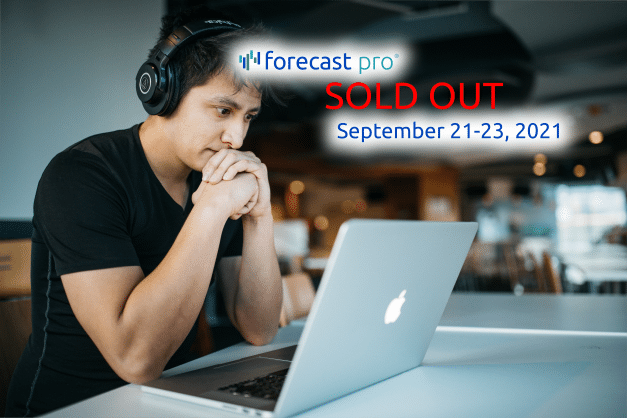Workshop Overview
You will leave this comprehensive three-day educational course with an understanding of forecasting techniques, including how they work and how to apply them in a real business environment. The workshop surveys the most commonly used business forecasting methods and will cover the following:
- How various forecasting methods work
- Pros and cons of each method
- How to implement best practices in Forecast Pro (via demonstrations using real-world examples)
The core of the workshop is 13.5 hours of live interactive presentations presented over a 3-day period. During the live sessions you will have the opportunity to pose questions to the instructors in real time as well as interact with the other attendees.
The workshop also includes 2 weeks of access to the workshop’s streaming channel and a 2-hour office hours session. The streaming channel provides on-demand access to prerecorded versions of the 8 modules presented in the live sessions along with 4 additional modules not covered in the live sessions. Office hours provide a 2-hour period the week after the live workshop where instructors will be available to answer questions regarding all topics covered in the workshop.
Who should attend?
The workshop is valuable for anyone whose job responsibilities include preparing or analyzing forecasts—some prior knowledge of statistics is helpful but not essential. The tutorials use Forecast Pro and real-world data to provide a deeper understanding of the forecasting methods and to show best practices; these lessons are applicable regardless of which forecasting software your organization uses.
Day 1
Introduction to Forecasting
Exponential Smoothing
Day 2
Extensions to Exponential Smoothing
Forecast Accuracy and Evaluation
Identifying Problems in Your Forecasting Process
Day 3
Event-Index Models
Multiple-Level Forecasting
New Product Forecasting
Office Hours
Questions & Answers
Additional On-Demand Presentations
Components of Data
Box-Jenkins (ARIMA) Models
Forecasting with Machine Learning
Dynamic Regression
Introduction to Forecasting
A broad overview of business forecasting and its various uses within the organization. Topics include approaches to forecasting, features of data, the role of judgment, selection of appropriate forecasting methods for varied data sets and resources for forecasters.
Components of Data
An in-depth look at the different components found in time series data including trends, seasonal patterns, business cycles, trading-day variations, interventions (events) and noise. Discussion includes the forms the components can take, spotting local vs. global components, interpretation of business cycle indicators and the use of decomposition routines.
Exponential Smoothing
A survey of exponential smoothing techniques with particular emphasis on the Holt-Winters family of models. Topics include the pros and cons of using these models, when they are best used, how they work, identifying model components, parameter optimization and model diagnosis.
Extensions to Exponential Smoothing
This session examines three useful extensions to the exponential smoothing model family. The first is the NA-CL model which will often improve forecast accuracy for data sets that exhibit a “selling season” whereby the majority of the demand occurs at specific times of the year (e.g., snow shovels, flu vaccines, etc.). The second is the Croston’s Intermittent Demand Model which is used to forecast data that exhibit frequent zero demand periods. The third is the Custom Component Model which allows some of the components to be estimated from the data and others to be customized by the forecaster.
Box-Jenkins (ARIMA) Models:
An exploration into the use of ARIMA models for business forecasting. Topics include the advantages/disadvantages of using these models, how and when they should be applied, automatic identification procedures and model diagnostics.
Forecast Accuracy and Evaluation
A detailed look at evaluating the accuracy of forecasting methods. Topics include the distinction between within-sample and out-of-sample errors, a survey of error measurement statistics, a summary of findings from forecasting competitions, and an explanation of how to use both real-time tracking reports and simulations as predictors of model performance.
Identifying Problems in Your Forecasting Process
Approaches for focusing on critical items when forecasting large volumes of data. Topics include evaluating and forecasting SKU data, filtering and ABC (Pareto) classification, outlier detection and correction, exception reporting and measuring accuracy across multiple time series.
Event-Index Models
Event-index models extend the functionality of exponential smoothing models by providing adjustments for promotions, strikes and other non-calendar-based events. This session addresses how these models work, how and when they should be used, and how to customize their design to best suit your needs.
Multiple-Level Forecasting
This session explores hierarchical forecasting techniques. Topics include the need for forecasting at various levels, product vs. geographical hierarchies, reconciliation strategies, top-down vs. bottom-up approaches, the use of proportional allocation and adjustment for seasonality.
New Product Forecasting
This session explores various approaches for forecasting new products. Topics include the pros and cons of different methods based on a product’s classification and a review of popular methods including item supersession, forecast by analogy and the Bass diffusion model.
Forecasting with Machine Learning
This session overviews the basics and benefits of forecasting with machine learning (ML). Topics include the basics of machine learning powered forecasting, when ML is likely to improve your forecasts, how to use the completely automatic ML option in Forecast Pro and how to build custom ML models in Forecast Pro.
Dynamic Regression
A detailed look into the ins and outs of regression forecasting. Topics include when regression models are best applied, how to build the models, ordinary least squares, leading indicators, lagged variables, Cochrane-Orcutt models, hypothesis testing and the use of “dummy” variables.
Registration
Registration Fee: The registration fee is $495 USD per attendee. A Team Discount price of $395 per attendee is available to organizations registering 3 or more attendees.
Class size: Due to the interactive nature of the live presentations, attendance is limited to 25 and attendees will be registered on a first-come-first-served basis.
Hours:
September 21-23: The workshop will run from 11:00 a.m. to 3:30 p.m. each day (USA Eastern Daylight Time (UTC/GMT -4 hours)). The office hours session will run from 11:00 a.m. to 1:00 p.m on Tuesday, September 28.
October 26-28: The workshop will run from 11:00 a.m. to 3:30 p.m. each day (AEDT (UTC/GMT +11 hours)). The office hours session will run from 11:00 a.m. to 1:00 p.m. on Wednesday, November 3.
December 7-9, 2021: The workshop will run from 11:00 a.m. to 3:30 p.m. each day (USA Eastern Standard Time (UTC/GMT -5 hours)). The office hours session will run from 11:00 a.m. to 1:00 p.m on Tuesday, December 14.
Cancellation Policy: The workshop is limited in size and we ask that if you must cancel to please inform us as soon as possible. Attendees may receive a full refund if cancellation is made 14 days or more prior to the start of the workshop. Registrants who fail to attend or cancel less than 14 days before the start date are not entitled to receive a refund. Personnel substitutions may be made at any time.
Instructors
Eric Stellwagen
Eric Stellwagen is the co-founder of Business Forecast Systems, Inc. (BFS) and the co-author of the Forecast Pro software product line. With more than 30 years of expertise in the field, he regularly presents workshops and publishes on the topic of business forecasting, and is widely recognized as a leading educator on the subject. Drawing upon his extensive consulting experience helping organizations to address their forecasting challenges, Eric infuses his classes with practical approaches and uses real-world data to illustrate concepts. He has worked with many leading firms including Coca-Cola, Kraft, Merck, Nabisco, Owens-Corning and Verizon and has presented workshops for a variety of organizations including APICS, the International Institute of Forecasters (IIF), the Institute of Business Forecasting (IBF), the Institute for Operations Research and the Management Sciences (INFORMS), and the University of Tennessee. Eric served on the board of directors of the IIF for 12 years and is currently serving on the practitioner advisory board of Foresight: The International Journal of Applied Forecasting.
the co-founder of Business Forecast Systems, Inc. (BFS) and the co-author of the Forecast Pro software product line. With more than 30 years of expertise in the field, he regularly presents workshops and publishes on the topic of business forecasting, and is widely recognized as a leading educator on the subject. Drawing upon his extensive consulting experience helping organizations to address their forecasting challenges, Eric infuses his classes with practical approaches and uses real-world data to illustrate concepts. He has worked with many leading firms including Coca-Cola, Kraft, Merck, Nabisco, Owens-Corning and Verizon and has presented workshops for a variety of organizations including APICS, the International Institute of Forecasters (IIF), the Institute of Business Forecasting (IBF), the Institute for Operations Research and the Management Sciences (INFORMS), and the University of Tennessee. Eric served on the board of directors of the IIF for 12 years and is currently serving on the practitioner advisory board of Foresight: The International Journal of Applied Forecasting.
Sarah Darin
Sarah Darin has 20 years of experience with statistical consulting, sales forecasting, regression modeling and marketing analytics. Sarah holds a Master’s of Science in Statistics from the University of Chicago, where she also served as a Lecturer for two years. She has consulted for clients across a broad range of industries, including Consumer Packaged Goods, Telecommunications, Technology, Retail, Automotive and Finance. Before joining BFS, Sarah was Vice President of Consulting Services at Nielsen where she focused on custom analytic solutions for the CPG and Expanded Vertical practices, teaching customers how to efficiently integrate, manage, model and forecast large-scale datasets. Sarah’s ability to understand and explain statistical concepts in the context of real-world, messy data makes her an ideal instructor for this workshop. Sarah received her undergraduate degree in Applied Mathematics from Harvard University.
20 years of experience with statistical consulting, sales forecasting, regression modeling and marketing analytics. Sarah holds a Master’s of Science in Statistics from the University of Chicago, where she also served as a Lecturer for two years. She has consulted for clients across a broad range of industries, including Consumer Packaged Goods, Telecommunications, Technology, Retail, Automotive and Finance. Before joining BFS, Sarah was Vice President of Consulting Services at Nielsen where she focused on custom analytic solutions for the CPG and Expanded Vertical practices, teaching customers how to efficiently integrate, manage, model and forecast large-scale datasets. Sarah’s ability to understand and explain statistical concepts in the context of real-world, messy data makes her an ideal instructor for this workshop. Sarah received her undergraduate degree in Applied Mathematics from Harvard University.





